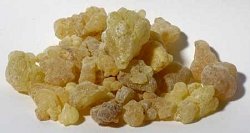Last week,
we learned about the power of gold. This week, as promised, I found out about
the second gift of the Magi—Frankincense.
Frankincense
is actually a type of resin that “bleeds” from certain hardy trees found in the
arid areas of the Middle East. It is harvested by making cuts in the bark—the
first bits to ooze out are not the highest value, but the second and third cuts
bear a better quality resin.
For over
five thousand years, Frankincense, known simply as “incense” has been traded in
and around the countries of the Mediterranean. Banned for many years by the Christian
churches for its connection to Jewish spirituality, it later became called
Frankincense when Frankish Crusaders brought it back to Europe from the Middle
East.
The resin
burns due to the natural oils present, and was used as an incense in the
ancient world, where bathing was not exactly a daily habit. Its piney, lemony
smell would cover the scent of your neighbor’s body odor, as well as acting as
an insecticide. Good stuff, that, ‘cause if you ain’t bathing, odds are good
you’ve got some sort of insect taking up residence on your body without a lease
or any sort of permission.
Another
benefit comes from the smoke from the burning resin—it is said to be good for
clearing out germs from the air, thereby bringing good health to a home in
which it was burned every day. The scent is quite calming and is used today in
meditation as a way to center the mind and body.
Taken
internally, the ancients would use the resin to aid in digestion, as well as
for treating tumors, ulcers, and dysentery. Pliny the Elder (who we have to
respect—after all, he is an elder) even claims that the resin could be used as
a cure for hemlock poisoning. Too bad Socrates didn’t have some stashed in his
robes, although from what I hear, it wouldn’t have done him any good with the
Athenian people out for his blood.
But if he
had tried to escape and had suffered superficial wounds, he could have used the
oil of his handy-dandy hemlock to treat those wounds. Also good for acne, and
when added to a bath, for the treatment of cramps. The ashes of the burned
stuff were used to make kohl to line the eyes of Egyptian royalty and it was
also used to mummify them at their deaths (one would hope they were dead,
anyway).
For the
treatment of acne and cramps alone, I’m thinking of picking up a bottle. For the
baby Jesus, there were lots of reason why this yellowish/clear resin would make
a good gift. It just would not do for the son of a deity to have zits or smell
bad or have a tummy-ache.
Next week, assuming we all don’t meet our fiery ends
on December 21st, I’ll talk about the properties of myrrh, which
seems to be a close cousin to Frankincense.
By the way, if you would like to buy some, too, I found it for sale on Amazon, which is where I got the pretty piccie.

No comments:
Post a Comment